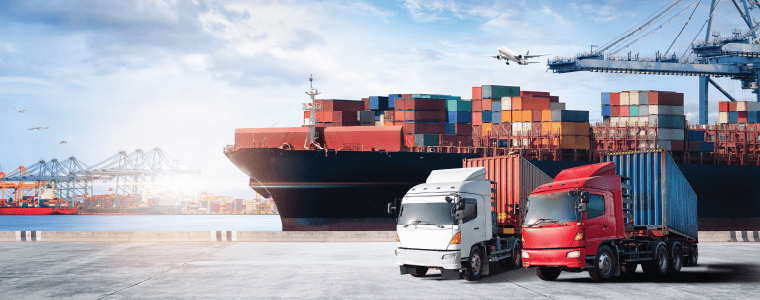International Freight Solutions – Your Guide to Global Shipping

International trade has never been more important for businesses. You also need to have the best international freight solutions available to compete on a global scale. With the right approach, moving goods across borders doesn’t need to be daunting. By learning the main freight options, knowing the challenges, and choosing the right partners, you can move products worldwide with confidence.
From air freight and sea shipping to courier services and digital logistics, you’ll obtain clear explanations without jargon, helping you make informed decisions.
Let’s look at how international freight solutions can open opportunities for your business and what you need to consider.
What You Need to Know About International Freight Solutions
International freight solutions cover the methods, systems, and services that help you transport goods across borders. They ensure that your products move safely, legally, and efficiently from one country to another.
Freight forwarding is often confused with logistics services, but the two play slightly different roles. Freight forwarders:
- Act as intermediaries
- Arrange transport with carriers
- Prepare documentation
- Ensure smooth movement through customs
Logistics services, on the other hand, usually refer to the wider supply chain, which may include:
- Warehousing
- Distribution
- Stock management alongside transport
Direct shipping involves dealing with carriers directly, which can work for businesses with predictable, high-volume routes. Nevertheless, it’s often too complex for smaller companies without specialist knowledge.
Having specific freight options is essential. The needs of small e-commerce retailers sending parcels to Europe are different from those of manufacturers shipping machinery to Asia. Factors such as the type of goods, the scale of trade, and the urgency will determine the most suitable method.
The Main Types of International Freight Solutions
- Air Freight
Air freight is the fastest way to move your goods internationally. It works best for speed-sensitive or high-value products, such as electronics, pharmaceuticals, or fashion items, where timing is crucial.
The advantages are speed, security, and reliability. Your goods can reach destinations across continents within days. Air freight services also tend to have rigorous tracking and handling processes. The downside is cost. Air freight is significantly more expensive than other methods, and weight restrictions can make it unsuitable for bulk shipments.
- Sea Freight
Sea freight remains one of the most widely used shipping options, especially for bulk goods and heavy cargo. Containers allow you to ship everything from raw materials to finished products in large volumes.
The cost advantage is significant when compared to air freight. Sea freight also offers a global reach, with established trade routes linking every major market. The main drawback is time. Sea shipping is slower, and delays can occur at ports due to congestion or customs processes. For non-urgent shipments, however, it is often the most cost-effective choice.
- Road Freight (for European Trade)
For trade with European markets, road freight continues to play an important role despite new post-Brexit challenges. Lorries and vans can provide door-to-door delivery across Europe, making it a flexible solution.
The benefits include short lead times within neighbouring markets and the ability to ship smaller loads directly to customers. Nevertheless, customs checks, driver shortages, and congestion can create delays, making planning even more important than before.
- Rail Freight
Rail freight has grown in importance, especially with increasing focus on sustainable logistics. It provides a middle ground between air and sea freight. It offers faster transit times than shipping and lower costs than air.
Rail routes are becoming more popular for certain sectors. However, availability remains limited, and it is not as fast as air freight. If you’re seeking an environmentally friendlier option, rail can be worth considering.
- Courier and Express Services
Courier services are often the best option if you need to move smaller packages quickly. They offer speed, convenience, and full tracking, which is vital for customer satisfaction in online retail.
The disadvantages are mainly around the cost per unit. Sending bulk goods through courier networks quickly becomes expensive, and the capacity is limited compared with sea or air freight. However, for high-frequency, low-volume shipments, express services are hard to beat.
Considerations When Choosing International Freight Solutions
- Cost vs. Speed
You need to balance your budget with delivery deadlines. Air freight offers speed, but at a price, while sea freight provides savings but takes longer. A mix of methods may suit your company, depending on your product types and markets.
- Customs and Compliance
Moving goods internationally means dealing with paperwork. Customs declarations, Incoterms, and regulatory requirements all need to be handled correctly to avoid fines or delays. Working with a freight forwarder can help simplify your process.
- Reliability and Track Record
The cheapest option is not always the best. A reliable freight partner with a strong track record will reduce the risk of delays, damaged goods, or hidden costs. Always check references, accreditations, and case studies when selecting a partner.
- Technology and Tracking
Digital logistics platforms have transformed how companies monitor shipments. Real-time tracking and predictive alerts give you visibility over your supply chain, allowing faster decision-making if issues arise.
- Sustainability
With growing pressure from consumers and regulators, greener freight solutions are becoming essential. Rail freight, optimised sea routes, and carbon offset programmes can show your commitment to sustainability.
How Can You Select the Right Freight Partner
Freight forwarders play a critical role in managing the complexities of international trade. They act as intermediaries, ensure your goods move seamlessly across borders, handle documentation, and deal with carriers on your behalf.
When selecting a freight partner, consider these questions:
- Do they have true global coverage, with experience in the markets you plan to reach?
- Can they handle customs documentation and compliance with ease?
- What technology do they use, and will you have access to real-time tracking tools?
For SMEs, choosing a partner with experience in small-volume shipments and flexibility is often key. Larger corporations, however, may benefit from working with providers offering integrated logistics services, including warehousing and distribution. Match your business size and requirements with the right partner to ensure smoother operations.
Conclusion
Choosing the right international freight solution is about more than simply moving goods from one country to another. You need to balance cost and speed, ensure compliance, and build reliable partnerships if you want your business to grow globally with confidence.
Air freight, sea freight, road, rail, and courier services are all good freight options, depending on your products and markets. Take the time to assess your options and work with the right freight partner. This will help streamline your supply chain and strengthen your international presence.




